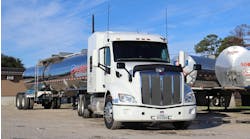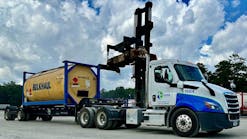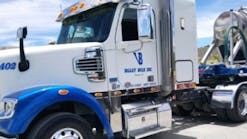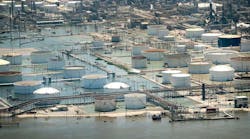Hurricane recovery requires advance preparation, dogged determination
YOU never want to have first-hand experience with a Category 4 hurricane.
But it’s a risk faced by every Gulf Coast business and resident, and Lori Pavlish faced it head-on when Hurricane Harvey bashed the Texas coast on August 25.
Pavlish, who works in The Dow Chemical Company’s global supply chain transportation safety and security department, owns a house in Rockport—where Harvey’s eye hit shortly after making landfall on San Jose Island—that sustained damage. She also has a residence 65 miles inland in Victoria and was not pleased when Harvey “came to visit me” after hammering the coast.
“It was a double whammy, but I learned a lot,” she said during the Intermodal Tank Container Association’s 2017 Intermodal Bulk Liquid Symposium held October 26 in Kemah, Texas. “
In her presentation, “Predicting the Unpredictable,” Pavlish imparted some of that wisdom.
Based on personal experience, she said those in the way of a major storm should do the following while they have the chance:
• Fill vehicles up with fuel before the event: no power means no gas pumps.
“I know everybody in this room knows this, but write it on the back of your hand in Sharpie,” she said.
• Get cash, including small bills, so you don’t need a lot of change.
• At least two days before the event, fill any prescriptions needed for your household for at least the next 10 days.
• Turn off all of the utilities to your home and business before evacuating.
• Pre-emptively empty out the freezer and refrigerator.
• Buy lots of peanut butter and bagels.
• Calculate potential fuel usage for a generator and stock up.
• Take photos of the “before”; open closet doors and cabinets; protect critical documents.
• Buy heavy contractor bags and zip-ties, furniture moving bags, bleach, and microbial control product—then use them!
• Don’t place items near the windows or doors.
• Have an alternate means to enter a building (because the primary may not work).
• Conduct an emergency drill. Kill the power to your home or business for several hours. What dependencies do you have or necessities that you haven’t considered? (i.e., generator for home medical equipment, refrigeration for medicines, anti-anxiety remedy for teens in electronic device withdrawal).
• Invest the time to actually read your insurance policies before you need them. Is cost of debris removal included? Probably not.
• Keep your trees trimmed and property clear of loose objects year-round.
In the aftermath, if you must clean up debris,
be aware that FEMA requires it to be sorted. In an effort to expedite the debris-removal process, FEMA requires that debris should be placed curbside. Placing debris near or on trees, poles, or other structures makes removal difficult. This includes fire hydrants and meters.
FEMA asks that debris be separated into these six categories:
• Electronics. TV, computer, stereo, phone, DVE player.
• Large appliances. Refrigerator, washer/dryer, air conditioner, stove, water heater, dishwasher.
• Hazardous waste. Oil, battery, pesticide, paint, cleaning supplies, compressed gas.
• Vegetative debris. Tree branches, leaves, logs, plants.
• Construction debris. Building materials, drywall, lumber, carpet, furniture, plumbing.
• Household garbage. Bagged garbage, discarded food, paper, packaging.
She said a business continuity plan (BCP) is not optional. A business impact analysis (BIA) should involve these steps:
• Develop a questionnaire.
• Conduct a workshop to instruct business function and process managers how to complete the BIA.
• Receive completed BIA questionnaire forms.
• Review BIA questionnaires.
• Conduct follow-up interviews to validate information and fill any information gaps.
Recovery strategies:
• Identify and document resource requirements based on BIAs.
• Conduct gap analysis to determine gaps between recovery requirements and current capabilities.
• Explore recovery strategy options.
• Select recovery strategies with management approval.
• Implement strategies.
Plan development:
• Develop plan framework.
• Organize recovery teams.
• Develop relocation plans.
• Write business continuity and IT disaster recovery procedures.
• Document manual workarounds.
• Assemble plan, validate, gain management approval.
Testing and exercises:
• Develop testing, exercise, and maintenance requirements.
• Conduct training for business continuity team.
• Conduct orientation exercises.
• Conduct testing and document test results.
• Update BCP to incorporate lessons learned from testing and exercises.
Other tips:
• If the primary work site is damaged, is it possible to operate from a remote site (electronic back-up)?
• Pre-stage generators and fuel supply to support safety critical functions.
• Consider additional bracing for roll-down (garage) type doors.
• Establish a process to contact employees after the storm, to verify their safety, understand their constraints to returning to work, and provide support as possible.
“One company recommended the use of a group text message,” she said. “One company gave employees the option to transfer some of their vacation to other employees who were not able to return to work due to storm-recovery activities. One company paid employees who were not able to return to work due to damage to the work site, but asked them to volunteer in their community on storm-recovery activities instead.”
• Investigate options for “letter of permission” from local authorities to return to impacted areas.
• Consider use of satellite telephones and marine back-up chargers.
• Consider facility security for extended evacuation.
• Consider investigating your state’s Business Emergency Operations Center (each state has one).
• Consider placement of equipment. Review FEMA flood maps (available online).
• Document processes for evaluating equipment for return to service: facilities, transportation equipment. How do you know it’s safe to operate?
• Review contracts with generator rental companies, security services each year. Make calls while the wind is still blowing (and before lines go down) to get on the list, or “start the list.”
• Train and retrain employees on business contingency plans; develop what-if scenarios with alternate paths for variables.
• Work with employees to encourage them to have a personal emergency response plan.
• Train employees on responding to customer requests for services during unsafe conditions. Just say no (politely and early).
“Natural disasters can bring out the worst in some people,” she said, “But disasters also absolutely bring out the best in many more people.”









